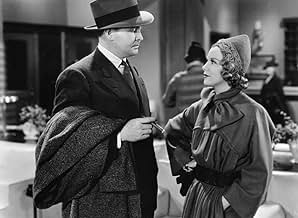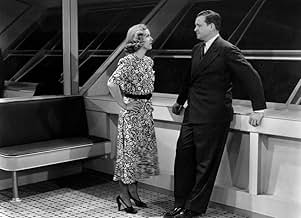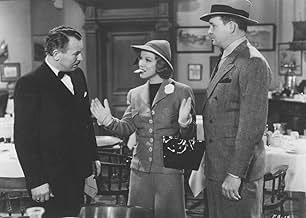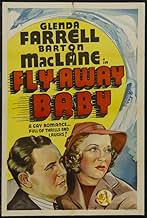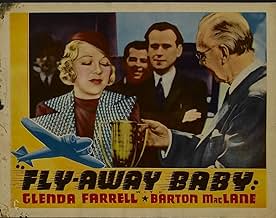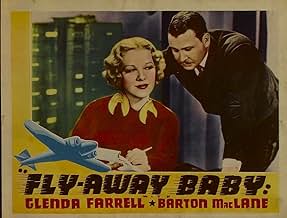Agrega una trama en tu idiomaTorchy Blane tries to solve a murder and smuggling case during a round-the-world flight.Torchy Blane tries to solve a murder and smuggling case during a round-the-world flight.Torchy Blane tries to solve a murder and smuggling case during a round-the-world flight.
- Dirección
- Guionistas
- Elenco
Joe King
- Mr. Guy Allister
- (as Joseph King)
Glen Cavender
- George - Globe Chop House Manager
- (sin créditos)
Lane Chandler
- Policeman Announcing Miss Sayre
- (sin créditos)
Don Downen
- Herald Copy Boy
- (sin créditos)
Earl Dwire
- Globe Chop House Waiter
- (sin créditos)
Eddie Graham
- Man at Bar with Sprague
- (sin créditos)
- Dirección
- Guionistas
- Todo el elenco y el equipo
- Producción, taquilla y más en IMDbPro
Opiniones destacadas
Jeweler Milton Deveraux is murdered during a break in of his store. Lt. Steve MacBride is perplexed, but girlfriend Torchy Blane suspects Lucien Croy, reporter for the rival Star Telegram (who is only on the paper because his father, owner and publisher, wants him to earn a living ) because Croy has amassed large gambling debts, but Croy is alibied by Guy Allister (Deveraux's partner) and Ila Sayre (nightclub singer and Croy's girlfriend). Torchy still suspects Croy of being part of the jewel heist, so thanks to her editor and publisher, accompanies him on a promotional race-around-the-world flight, also joined by Hughie Sprague (reporter for the Daily Journal) and former police traffic driver, Gahagan, who is now a private detective watching Sprague for some reason. Ila later confesses to MacBride that Croy's alibi was not what it seemed, and MacBride races to Frankfurt to arrest Croy for the murder of Deveraux and the jewel theft, but is it as simple as all that? Excellent entry in the Torchy Blane series with plenty of mystery that left this viewer curious to the end, with plenty of twists and turns. The performances of Farrell and MacLane are the same fun as the last picture (also picking up where the last film left off with Torchy trying to get MacBride to the altar) and the comic relief between Kennedy (Gahagan) and O'Connell (Sprague) was played down to the point where it was enjoyable. Rating, based on B mysteries, 8.
A man is murdered in his apartment and thousands of dollars worth of diamonds are stolen. There is little evidence to trace the killer with, although Torchy Blane (Glenda Farrell) does manage to find the murder weapon. She is convinced that Lucien Croy (Gordon Oliver) had something to do with it, although Lt. McBride (Barton MacLane) is not so sure. Croy seems to have an airtight alibi. On top of the investigation, Croy is going on a trip round the world as a publicity stunt for his newspaper. Torchy decides that tagging along is the perfect way to track him in spite of McBride's wishes.
A fun movie throughout, this second of the Torchy Blane films is entertaining but unimportant. There is a formula to these movies. Man is murdered, Torchy and McBride team up to solve it, it is solved, they announce their impending marriage. It isn't the story that makes these films rewatchable; it is the vibrant personality of Farrell. A beauty with brains, she is incredibly under-appreciated.
A fun movie throughout, this second of the Torchy Blane films is entertaining but unimportant. There is a formula to these movies. Man is murdered, Torchy and McBride team up to solve it, it is solved, they announce their impending marriage. It isn't the story that makes these films rewatchable; it is the vibrant personality of Farrell. A beauty with brains, she is incredibly under-appreciated.
Back in Jules Verne's steam-powered 19th Century, a trip around the World in only 80 days was considered astounding. In 1924 two U. S. Army aviators managed it in a new world record of 15 days, 11 hours. But that was nothing! In 1937 Warner Brothers second feature Fly-Away Baby, Glenda Farrell as irrepressible, smart-girl reporter Torchy Blane zips around the world in less than 30 minutes, using only the final half of the fast-moving, action-packed one-hour movie. All done with stock footage of the vehicles used and still pictures or footage of the various cities Torchy passes through, the mood for each locale set with appropriate regional music. All the while, a bold line meanders across a map of the Pacific Ocean, Asia, and Europe with the shadow of an airplane following along, motors humming. Lengthy scenes in Honolulu and Stuttgart are economically but artfully dispatched with small sets and back-projection. You may be so swept away by this Old Hollywood magic, and so absorbed into this engrossing, lightning-paced mystery pot-boiler, you will feel as if you've actually been to San Francisco, Hong Kong, and Suttgart with Torchy. And wow! what a window into time! You get to see file footage of a huge China Clipper taking off from a choppy sea, a gigantic Zepplin majestically gliding though the clouds, and a shot of the yet unfinished Golden Gate Bridge -- not to mention the usual swarms of boxy , spoke-wheel automobiles to be seen careening about the streets of 1930's motion pictures.
The Torchy Blane series was a chance for reliable Warner supporting players Glenda Farrell and Barton MacLane to strut their stuff in lead roles for a change. And they both shine! He's Torchy's tough cop boy friend Steve McBride, who needs her help to dope out the cases he's not sharp enough for. At least that's the way she tells it. Fly-Away Baby has the crime-solving duo after a diamond thief/murderer. The main suspect (Gordon Oliver), who is a columnist of a newspaper rival to Torchy's, is making an around-the-world promotional trip. Torchy and Steve suspect the crook will try to sell the hot diamonds somewhere along the way, so Torchy convinces her own newspaper publisher (Henry Davenport) to spring for her to follow along in what is promoted as an "around the world race." Hugh O'Connell provides sophisticated comedy relief as another reporter in the so-called race. A dandy with a rich wife, he's always bragging to his no-class cronies about spending her money and playing around on her. Little does he know his suspicious spouse has hired Steve's muddled, philosophical driver Gahagan (Tom Kennedy) to tag along and keep an eye on him. Steve joins Torchy in Stuttgart, where another murder takes place, then they take off aboard the Zepplin for the final leg of the journey and the exciting denouement. The airship scenes are very impressive for a B-movie.
Fly-Away Baby is not quite so good as the first in the Torchy series, Smart Blonde (1937) (see my review). But Smart Blonde was something special, really a tough act to follow, and Fly-Away Baby is still wonderful. Fast-talking, fast-moving, breezy, funny, engaging, exciting, beautifully filmed, and expertly acted, especially by the two charming leads -- a delight from beginning to end. All handsomely wrapped up in polished production values only a slice below what you would expect from one of Warner Brothers' top "A" pictures. Director Frank McDonald, a career B-picture specialist, and film editor Doug Gould pack so much action into sixty minutes of running time, it's like five gallons of slick, smooth Classic Hollywood entertainment concentrated into a half-pint movie!
It's never ceases to amaze how the big studios of Old Hollywood could turn out these minor masterpieces while bringing to bear only a fraction of their available resources.
The Torchy Blane series was a chance for reliable Warner supporting players Glenda Farrell and Barton MacLane to strut their stuff in lead roles for a change. And they both shine! He's Torchy's tough cop boy friend Steve McBride, who needs her help to dope out the cases he's not sharp enough for. At least that's the way she tells it. Fly-Away Baby has the crime-solving duo after a diamond thief/murderer. The main suspect (Gordon Oliver), who is a columnist of a newspaper rival to Torchy's, is making an around-the-world promotional trip. Torchy and Steve suspect the crook will try to sell the hot diamonds somewhere along the way, so Torchy convinces her own newspaper publisher (Henry Davenport) to spring for her to follow along in what is promoted as an "around the world race." Hugh O'Connell provides sophisticated comedy relief as another reporter in the so-called race. A dandy with a rich wife, he's always bragging to his no-class cronies about spending her money and playing around on her. Little does he know his suspicious spouse has hired Steve's muddled, philosophical driver Gahagan (Tom Kennedy) to tag along and keep an eye on him. Steve joins Torchy in Stuttgart, where another murder takes place, then they take off aboard the Zepplin for the final leg of the journey and the exciting denouement. The airship scenes are very impressive for a B-movie.
Fly-Away Baby is not quite so good as the first in the Torchy series, Smart Blonde (1937) (see my review). But Smart Blonde was something special, really a tough act to follow, and Fly-Away Baby is still wonderful. Fast-talking, fast-moving, breezy, funny, engaging, exciting, beautifully filmed, and expertly acted, especially by the two charming leads -- a delight from beginning to end. All handsomely wrapped up in polished production values only a slice below what you would expect from one of Warner Brothers' top "A" pictures. Director Frank McDonald, a career B-picture specialist, and film editor Doug Gould pack so much action into sixty minutes of running time, it's like five gallons of slick, smooth Classic Hollywood entertainment concentrated into a half-pint movie!
It's never ceases to amaze how the big studios of Old Hollywood could turn out these minor masterpieces while bringing to bear only a fraction of their available resources.
Its rather amazing that this series isn't more widely seen.
Superficially, they are B movies and at the cheapy end. They have incredibly uninteresting stories, stuff about the mob.
But they're really impressive in a way. I guess it doesn't register today, but these were either important in their day or if you wish reflected something important.
For non-US readers, you have to know that women couldn't vote until very late in the history of the US. Blacks first, then women. The time of this movie is five times further away from us than it is from the first national election where women voted.
A woman could be a wife, a nurse, teacher, secretary, whore.
Or, in movies if she was bright, a newspaper reporter. You have to understand also that the thirties was a period of great experimenting in narrative folding: stories that in some way included the making of stories. One common fold was the newspaper guy who "got the story" just as we are. He was our avatar, our representative in the thing.
These experiments from the thirties played with different notions of storygetter, some comic, some inverted.
So here you have a bright woman reporter. Feisty. Pretty. She's engaged to an "official" detective, a cop. But she keeps missing the wedding because she goes off chasing the story.
Together, they get the crook and solve the case, but always with her in the lead. He protects and she loves him, the "big lug." Though this is black and white, the audience would know (from posters, fan magazines and her name) that she is redheaded.
It was a long-lasting sequence of movies, as many as, say, the Charlie Chan ones and with far more than the celebrated "Thin Man." So I invite you to watch this or any of the series. She's an icon that's all the more fascinating because it has ceased having power. Now that's interesting.
Ted's Evaluation -- 3 of 3: Worth watching.
Superficially, they are B movies and at the cheapy end. They have incredibly uninteresting stories, stuff about the mob.
But they're really impressive in a way. I guess it doesn't register today, but these were either important in their day or if you wish reflected something important.
For non-US readers, you have to know that women couldn't vote until very late in the history of the US. Blacks first, then women. The time of this movie is five times further away from us than it is from the first national election where women voted.
A woman could be a wife, a nurse, teacher, secretary, whore.
Or, in movies if she was bright, a newspaper reporter. You have to understand also that the thirties was a period of great experimenting in narrative folding: stories that in some way included the making of stories. One common fold was the newspaper guy who "got the story" just as we are. He was our avatar, our representative in the thing.
These experiments from the thirties played with different notions of storygetter, some comic, some inverted.
So here you have a bright woman reporter. Feisty. Pretty. She's engaged to an "official" detective, a cop. But she keeps missing the wedding because she goes off chasing the story.
Together, they get the crook and solve the case, but always with her in the lead. He protects and she loves him, the "big lug." Though this is black and white, the audience would know (from posters, fan magazines and her name) that she is redheaded.
It was a long-lasting sequence of movies, as many as, say, the Charlie Chan ones and with far more than the celebrated "Thin Man." So I invite you to watch this or any of the series. She's an icon that's all the more fascinating because it has ceased having power. Now that's interesting.
Ted's Evaluation -- 3 of 3: Worth watching.
Torchy (Glenda Farrell) and her boyfriend, Steve (Barton MacLane) are once again preparing to get married. And, once again, a murder occurs and derails their plans. This is a perennial theme in this series as well as in the Falcon and Bulldog Drummond.
The police, naturally, arrest the wrong man and Torchy thinks that the real killer is going on a worldwide race--and she intends to chase him and prove his guilt. However, there are a lot of twists and turns and she isn't exactly right--but of course she saves the day by the end of the film. All of this is very, very ordinary...EXCEPT the location of the final portion of the film. During this worldwide jaunt, the trail leads to Germany...yes, NAZI Germany! And, with the help of the German police, the mystery is solved...ABOARD THE HINDENBURG!!!! For an ex-history teacher like me, it made the film worth seeing--even if the plot really is a bit pedestrian.
The police, naturally, arrest the wrong man and Torchy thinks that the real killer is going on a worldwide race--and she intends to chase him and prove his guilt. However, there are a lot of twists and turns and she isn't exactly right--but of course she saves the day by the end of the film. All of this is very, very ordinary...EXCEPT the location of the final portion of the film. During this worldwide jaunt, the trail leads to Germany...yes, NAZI Germany! And, with the help of the German police, the mystery is solved...ABOARD THE HINDENBURG!!!! For an ex-history teacher like me, it made the film worth seeing--even if the plot really is a bit pedestrian.
¿Sabías que…?
- TriviaThough released six weeks after the Hindenburg disaster, which put a stop to all commercial dirigible flights, the film's climax occurs on a German dirigible and it contains stock footage of the Hindenburg (LZ-129).
- ErroresThe map of Torchy's flight "shows" it ending in Frankfurt, Germany, but it's actually flying to Berlin. Frankfurt, where Zeppelin flights took off from and arrived at, is much farther to the west.
- Citas
Sgt. Orville Gahagan: [to a gaggle of reporters trying to get into the crime scene, including Torchy] Orders is no reporters, male or female - especially female!
- ConexionesEdited from Flirtation Walk (1934)
Selecciones populares
Inicia sesión para calificar y agrega a la lista de videos para obtener recomendaciones personalizadas
Detalles
- Tiempo de ejecución
- 1h(60 min)
- Color
- Mezcla de sonido
- Relación de aspecto
- 1.37 : 1
Contribuir a esta página
Sugiere una edición o agrega el contenido que falta

